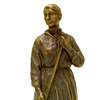artists
Marc-Aurèle de Foy Suzor-Coté (1869-1937)
Painter and sculptor, was born in Arthabaska, Quebec. A great
charmer, fashionably attired and possessing a baritone voice,
Marc-Aurèle de Foy Suzor-Coté at age 22, left for Paris, to complete
his training at the École des beaux-arts there.
Henri Harpignies, a landscape artist in the Corot style, introduced
him to outdoor painting. While his paintings complied with the
standards of “good taste” of the time, his bright colours and free
style drew their inspiration from the Impressionists.
The landscapes he presented in 1900 at the show by the Société des
artistes français and at the Exposition universelle in Paris
established his reputation as a highly talented painter, both in
Europe and back in Canada. He returned home in the summer of 1907,
at age 38, his training completed. An artist, he explained to
the Globe newspaper of Toronto, “must paint his own country. […]
that is the only thing you will paint well.”
Through his family contacts with Wilfrid Laurier, a lawyer in
Arthabaska, leader of the Liberal Party and future Prime Minister,
he was granted commissions that launched his career as a painter in
Canada.
Suzor-Coté was a versatile artist who also drew and sculpted, and
produced portraits, history paintings and female nudes. Landscapes
remained his first love, however. During his stay in France, he
travelled around Paris and along the coast of Brittany looking for
scenes bathed in light. But it was in his native country, in
Arthabaska, that he found his best sources of inspiration. He
constantly roamed the surrounding countryside, trying to capture the
soft light of dusk on the river at break-up time or on snow-covered
hills. His winter scenes are among his most remarkable canvases, in
fact. He tirelessly depicted views of his village like so many
tributes to Canadian nature, both sleeping in winter and emerging
from the snow and ice in spring. He also described his country
through pastels and sculptures of its rural inhabitants.
In 1927, he became paralyzed and was forced to give up his career as
an artist. In 1928 he moved to Daytona Beach, Florida, where he
gradually began drawing, sculpting and painting again. He died in
Daytona Beach, but is buried in the cemetery of his native town.
| Maria Chapdelaine | ||
|---|---|---|
|
|
|
